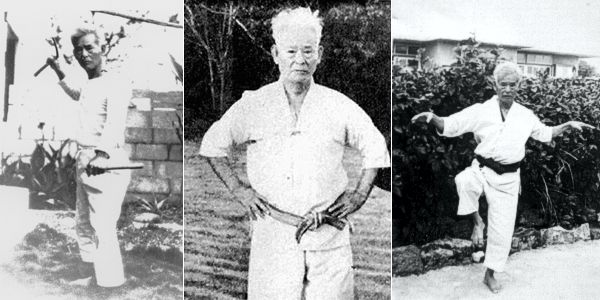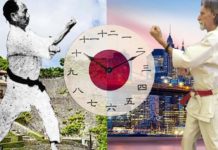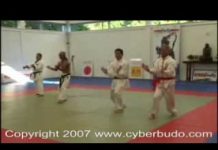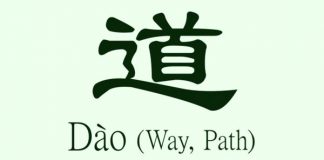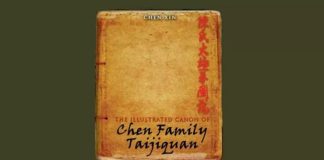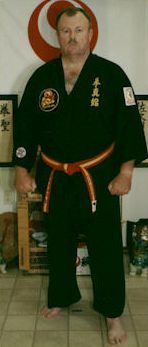 For centuries the martial arts have been cloaked in mystery and folk lore. The deadly techniques used by master practitioners of karate were frequently “hidden” inside a series of organized movements called katas. These choreographed movements consisting of blocks, strikes and kicks were the creative property of the karate masters that handed them down from generation to generation.
For centuries the martial arts have been cloaked in mystery and folk lore. The deadly techniques used by master practitioners of karate were frequently “hidden” inside a series of organized movements called katas. These choreographed movements consisting of blocks, strikes and kicks were the creative property of the karate masters that handed them down from generation to generation.
These “secret” techniques, known as bunkai, were not divulged lightly, and usually were revealed to family members only. As karate made its way to America in the late 50’s and early 60’s Okinawan masters were still very secretive when it came to teaching their art. According to Hanshi Mike Hancock Chief Instructor of the International Okinawan Budo-Kai there are very few American karatekas that truly understand the origins of their forms.
“About 90% of those practicing karate in the United States know little, if anything about their art other than the physical aspects,” said Hancock. “Those of us in the Okinawa Shorin Ryu Matsumura Seito Karate and Kobudo Association have a burning desire to learn the history and the origins of our art. To a certain degree, the veil of secrecy still exists. This coupled with a lack of written records, has created a void of information on the early years of Ryu Kyu martial arts. What information we have has been passed down to us from my teacher, Master Fusei Kise, the founder of Kenshin Kan Shorin Ryu.”
Hancock related a story that amplifies the traditional thought process of Master Kise when it comes to keeping the bunkai of a kata secret. It was a summer’s evening in the mid 80’s, Master Kise was on Hancock’s porch teaching a kata when a passing car slowed to a stop and began watching the practice session. Master Kise stopped the workout believing that the car contained students from another school who would “steal” his techniques.
The spectators were merely curious onlookers, but that situation reinforces the “old school” thinking that the Okinawan masters have when it comes to protecting the secrets connected to their katas.
After years of traveling between Okinawa and the United States, Master Kise decided to loosen centuries of restrictions surrounding the teaching of bunkai. For this story, Black Belt Magazine has been given permission to discuss and photograph selected bunkai techniques as related to Kenshin Kan Shorin Ryu Karate-Do.
The style has 23 empty hand katas along with a potpourri of weapons forms and White Crane forms. Kata Pinan Yondan was introduced to Hohan Soken’s system by Master Kise and is taught as an introduction to the White Crane.
“The first move in Pinan Yondan is an open hand block that represents the wings of a crane,” Hancock explained. “It appears that the hand above the head is to stop a punch to the head while the outstretched arm is used to block an upper body punch. This is how we teach it to the lower ranks. Once you step up in grade we teach the bunkai. In reality we are stepping backwards as the attacker moves forward, trapping his punching hand with a Crane block while striking the throat with a finger tip strike. This is one of the unseen moves in the form.”
Another bunkai technique in the form is to step backwards with a reinforced block that is really used more to strengthen the defenders “Ki” than it is to physically block an attack. The bunkai is to grab the attackers punching hand, angling it downward to expose a nerve on the radial bone, which is attacked with a back knuckle strike. It’s important to note that the wrist is bent giving maximum emphasis to the knuckles.
Ninth degree black belt Matt Molineux, also a Major in the U.S. Air Force and senior student of Hancock, explains the importance of kata in modern day karate and how kata training can be used in kumite or in a self defense situation.
“We take the forms and apply the bunkai when we fight,” said Molineux “A lot of systems do their kata then they fight a different way. We do not. How many times at a tournament have you seen kata performed beautifully, each one unique and defined? Yet when they fight, everybody looks the same. They’re not employing the techniques they’ve learned in their forms. We don’t play that game. Our style uses change of body and applies the bunkai of the kata.”
Change of body, called “taisabaki” by the Japanese, is a basic concept used to evade an attack. If you get out of the way, you’re not going to get hit; however this seemingly simple technique can take decades to master. That is why, Change of Body techniques are incorporated into the bunkai of many of Matsumura’s katas. Learning them requires relentless training and an inherent understanding of the katas “hidden techniques.
“The whole concept of our style is built around change of body,” said Molineux. “We try never to step back in a straight line. We always step at angles. So, change of body is actually angle stepping. Not being there when the punch or kick arrives is what we evolve to through our katas.”
Ananku is a kata designed specifically for street fighting. There are no preparatory moves such as chambering a punch. The form goes from one sequential move to another. But even this straight forward kata contains a hidden technique that may only be learned once Hancock deems the student ready for such knowledge.
“In Ananku I’m slipping a kick while doing a back knuckle and vertical punch against my attacker’s leg,” said Hancock. “At the same time I’m executing a toe kick into the muscle of his back leg. We also use a single-bone block and a double-bone block which allows us to slip a punch right into the attackers chin. This bunkai of the block-strike is taught to students after they reach black belt status. The Crane movement in the form allows us to slip the attackers punch while sliding under his arm and delivering a lethal finger tip strike to his throat. It’s important to note that this is a hidden technique and we only teach it to high-ranking black belts.”
The Naihanchi katas are considered by many to have been designed for fighting with ones back against a wall or along the dike of a rice paddy. According to Hancock this “false” information is another way the old Okinawan masters protected the secrets within their kata.
“Naihanchi is frequently seen being performed in a straight line,” said Hancock. “Sensei said that was a ruse put out by the Okinawans to cover up the proper bunkai. In Naihanchi we step cross-legged then stop for a second. During this pause we can determine from which direction the attack is coming. In Naihanchi 2 Master Kise actually steps out to the side and blocks two people. As I said, allowing others to believe the katas were designed with only one purpose in mind gave the Okinawans an edge because their hidden techniques were never shown to outsiders.”
Unlike the Korean art of Tae Kwon Do, and even some Japanese styles, Kenshin Kan Shorin Ryu Karate does not kick above the waist.
“I say if you can whip a roundhouse kick with great speed and power high enough to kick a man in the head, just imagine what you can do with a low kick,” explained Molineux. “If you want to kick a person in the head, first bend them to your waist using a low kick, and then after the’re bent over, kick‘em in the head.”
We frequently see old school masters kicking with their big toe. Covered in a mound of rock-hard callus the toe of an Okinawan master has gone through decades of being slammed against makiwaras and other toe toughing materials. And while it’s true that those kinds of toes can break ribs and shins, most individuals who train in karate don’t take it to that extreme. However even for those who do use their toes as a weapon, there is yet another hidden technique to be learned.
“You don’t really kick with the tip of the big toe, a toe kick is executed with the side of the big toe,” said Molineux. “And it’s best to use that kind of kick against soft tissue rather than landing a toe kick to a shin or other hard surface. Now Master Kise’s toe will break any bone you have to offer, but most Americans don’t emphasize that kind of toe development.”
Another noticeable difference between Kenshin Kan Karate and other Okinawan and Japanese styles is their stances. Once low-to-the-ground, Matsumura stylists have evolved to a more upright and natural position.
“There is definitely an emphasis on the upper body in our style,” said Molineux. “You will notice an extreme difference in stances if you were to compare Shorin Ryu, especially the Matsumura system to a style like Goju Ryu which uses a deeper rooted power stance. “We prefer a more natural stance, like that of someone walking down the street. We believe this natural position gives us more speed and agility.”
Throws, joint locks, and chokes aren’t unique to arts such as judo and jujitsu. Many of these techniques are found in the bunkai of numerous karate katas. Again, these are the “hidden” bunkai that are often unknown to anyone but the master of a system and his most trusted teachers.
“After watching Master Kise execute a technique that put his opponent on the floor using a wrist lock I said, ‘I’ve seen that technique before, it’s jujitsu,’” said Molineux. Master Kise replied, “No, no! Not jujitsu, just karate.”
Beginners must build a solid foundation of basics prior to learning the advanced bunkai of their katas. One method for perfecting basic techniques derived from various katas is called, “Ippon Kumite,” or “One Step Sparring.”
“Ippon Kumite allows students to use various punches, blocks, and kicks in a preset manner against another student,” said Molineux. “Essentially these are short katas. We practice one-step sparring to learn the fundamental concepts individually. Once these maneuvers are mastered students will be able to blend them together when they kumite. As the student rises in rank the one-steps are more defined, adding change-of-body. When a student achieves the rank of brown belt they will start using open hand techniques adding softness, combining that with change of body. Once that is perfected you don’t even have to block an attack. Using change of body, you avoid the attack then counter it using the advanced bunkai that had it’s beginnings with One-Step-Sparring.”
Both Hanshi Hancock and Hanshi Molineux are quick to emphasize the importance of the White Crane forms and their hidden techniques which defines the “change of body” bunkai that is so essential to Kenshin Kan Shorin Ryu.
“We study or Shorin katas that have White Crain techniques embedded in them because the Okinawan masters studied with Chinese masters and incorporated those techniques into their karate style,” said Molineux. “Many hard styles of karate went another way, omitting the Chinese forms. Our group however, was fortunate to have Shihan Tony Sandoval, a retired U.S. Marine and 10th degree black belt, teach us the White Crane katas and bunkai. This allowed us to add an element of refinement to our karate. Shihan Sandoval has nearly 50 years’ experience in the martial arts and spent 18 years on Okinawa-affording him the opportunity to train with dozens of karate teachers, including Master Kise. These forms were passed from old Chinese instructors to the old Okinawan instructors who, for many years, kept these forms very close to the vest. Only recently has Shihan Sandoval graciously decided to teach us these forms for fear that if they weren’t passed down now, they could be lost forever.”

